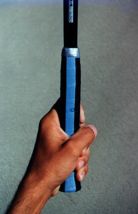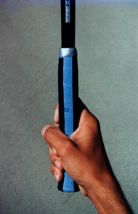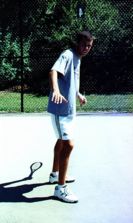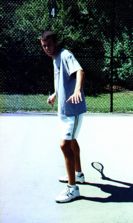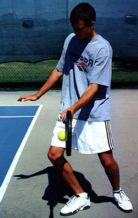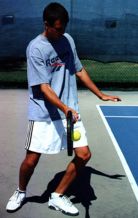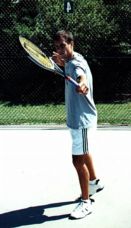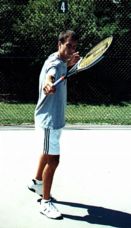June 2003 Article Turbo Tennis Archives:
Tennis Server
|

 |
Here we are in June, and in a very short time, we will have the thrills that only grass tennis can provide. Wimbledon is the last Grand Slam event to utilize this classic surface. If you have never played on grass, you really should. Tennis is a completely different game when played on this turf. If you have played on grass, you will know that the bounce varies greatly from court to court and from day to day. In fact, morning tennis on grass can be a completely different phenomenon than afternoon tennis. However, in comparing grass to other surfaces, two attributes are relatively consistently evident: speed and a lower bounce. Thus, it is not surprising that the semi-western and western varieties of forehand grips do not lend themselves to this surface. I truly believe that one of the reasons that Pete Sampras has faired so well at Wimbledon is due to the fact that he hits his blazing forehands with a traditional, eastern forehand grip. Eastern forehands can be extremely effective on a host of surfaces. They are often times best for doubles play. They do require effective preparation, and thus, are not as forgiving in some situations as the more modern, semi-western grip. Still, as a choice for a forehand grip, the eastern forehand is not a bad selection…regardless, of the surface. In our series of Integrated Tennis Strokes, we always begin with the grip. The eastern forehand grip is often described as the "shake hands with the racquet" grip. The cue of "shaking hands with the racquet grip" almost always puts the hand in an eastern forehand naturally. Another way to get this grip is to take your dominant hand and place the hand open on the strings of your racquet. Now, just slide the hand down to the racquet’s grip and you should be in a natural, eastern forehand grip. In describing the feel of the eastern forehand, you will note that the palm of your racquet hand seems to be directly on the side of the racquet handle’s grip. Many players who use the eastern forehand will say their grip is behind the racquet grip. With semi-western and western grips the "feel" is that the palm is more under the racquet handle. Below, you will see how the eastern forehand grip looks. Note that in the pictures above that the blue area represents the top of the racquet handle and the black areas represent the handle’s bevels. Also note that the base knuckle of the racquet hand seems to be place precisely on one of the sides of the racquet handle. In that the eastern forehand is a more classic oriented grip, it is usually best to hit this ball while in a closed stance. I think this is one reason that Pete Sampras’ running forehand is so devastating. While on the run, his body is naturally facing sideways to the net in a closed stance. Below is the ideal stance for hitting the eastern forehand. In the above pictures you are seeing Brent from the net’s perspective. Note that his racquet is facing straight back behind him as he prepares for this stroke. This is classic setup and preparation. Eastern forehands, as a result, are often times longer strokes. However, one can shorten the back swing with the eastern forehand and still enjoy success. In fact, when returning serve, this practice is almost a necessity. If you watch Pete Sampras return serve at Wimbledon, you will note that he deliberately shortens his back swing on this very fast surface. The opponent’s serve provides more than adequate pace for a good return when utilizing the shorter back swing. Next, of course, we need to address contact point. One of the advantages to the eastern forehand is that it provides a little more latitude or "play" when it comes to a desirable contact point. When tennis was played on a host of surfaces and players hit with wood racquets, this latitude made the eastern forehand the most flexible forehand grip. Even though I prefer the semi-western forehand grip in my game, I am not at all opposed to switching to the eastern forehand grip on extremely fast surfaces, or when the ball skips or does not bounce very high. The best contact point for the eastern forehand grip is really slightly in front of the lead shoulder or parallel with the front shoulder. In comparison to the western and semi-western forehand grips, the eastern grip allows you to take the ball a little bit "late." This is why I find myself switching to the eastern forehand grip against an overpowering opponent or when the surface is fast. Below, we see the best contact point for the eastern forehand grip. You will also note in the images above that the contact point that is most desirable is somewhere between the knee and the waist. On surfaces like clay or against opponents who use lots of topspin the ball bounces higher. The eastern forehand can be used against these higher bouncing balls but not as effectively as the semi-western or western grips. On clay, I think Pete Sampras is at a disadvantage when he uses the eastern forehand. His record on this surface supports my perception. Lastly, we need to address finish in our integrated approach. The best way to describe the proper finish when using the eastern forehand grip is to be pointing the racquet head where you want the ball to go. The racquet does not finish over the shoulder, as it should with the semi-western or western grips. Instead, the proper finish for the eastern forehand places the racquet in front of the body at about head height. This is the classic finish that was taught for years by teaching pros. Here is an image that illustrates the proper finish for the eastern forehand. Although the modern game sees more pros on the tour using the semi-western and western grips, the eastern forehand grip should not be demeaned or discarded. In reality, this grip has helped me out of many situations. It is a most worthwhile addition to your arsenal. The eastern forehand grip produces very powerful strokes. The ball that comes off the racquet when using an eastern forehand usually has little or no spin. It is very flat. If your setup and timing are good, however, a player can learn to really tag a forehand with this grip and still keep the ball within the white lines. The danger to using the eastern forehand grip is that you may find it a bit uncontrollable when pressed. Having said this, I would not be at all reluctant to use this grip on grass, on fast and low bouncing surfaces, when playing doubles (it allows me to get to my volley grip with less racquet rotation) or if I find myself being overpowered by an opponent. In the latter scenario, I have found that a short back swing with this grip allows me to block the ball back, but without sacrificing pace. When hitting the eastern forehand, you will note that your balls are going to naturally pass over the net at a lower height than when hitting the topspin oriented semi-western or western grip forehands. The eastern forehand is often times the best way to attack a net rusher who loves to serve and volley. So, my recommendation this summer while watching Wimbledon is to experiment with the eastern forehand. It may be just the addition you need to help you become a tennis overdog!!!
1996 - 2002 | 2003 - Present
This column
is copyrighted by Ron Waite, all rights reserved. Questions and comments
about these columns can be directed to Ron by using this form.
Ron Waite is a certified USPTR tennis instructor who took up the game
of tennis at the age of 39. Frustrated with conventional tennis methods
of instruction and the confusing data available on how to learn the
game, Ron has sought to sift fact from fiction. In his seven years of
tennis, Ron has received USTA sectional ranking four years, has successfully
coached several NCAA Division III men's and women's tennis teams to
post season competition, and has competed in USTA National singles tournaments.
Ron has trained at a number of tennis academies and with many of the
game's leading instructors.
In addition to his full-time work as a professor at Albertus Magnus
College, Ron photographs ATP tour events for a variety of organizations
and publications. The name of his column, TurboTennis, stems from his
methods to decrease the amount of time it takes to learn and master
the game of tennis.
|



October 2022 Tennis Anyone: Patterns in Doubles by John Mills. September 2022 Tennis Anyone: Short Court by John Mills. |
 You will join 13,000 other subscribers in receiving news of updates to the Tennis Server along with monthly tennis tips from tennis pro Tom Veneziano.
You will join 13,000 other subscribers in receiving news of updates to the Tennis Server along with monthly tennis tips from tennis pro Tom Veneziano. 
